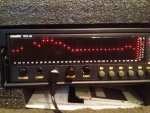Muddy T-Bone
New member
My Dynaudio BM5A MKII just arrived! I am so happy with this purchase, makes my mixing go so much quicker now.
I saw that Pro Audio Star had some re-man units on sale at $335ea so I ordered them. 5 days later, I check on-line to get a tracking number and their website shows the purchase as "processing". I called them, and the service rep told me they were sold out of the re-man units, but if I could hold out 1 or 2 days they had a shipment of A stock coming in and they would ship those instead if I agreed. Duhhhh OK, ship the new ones!
I've attached a picture of a spectrum analyser measurement of the Dyn's. Calibrated mic at seating level and distance, Pink noise source, playing thru my PC and USB interface. SPL at 83dB C weighted. Wow... ruiler flat response from 600 to 10kHz. Then a slow rise from 500hz peaking +4db in the 250 to 125Hz range. This in an untreated room.
I have never measure a pair of speakers that were ruler flat for 4 octaves!
Great price, great product, I could not be happier with my purchase.
I saw that Pro Audio Star had some re-man units on sale at $335ea so I ordered them. 5 days later, I check on-line to get a tracking number and their website shows the purchase as "processing". I called them, and the service rep told me they were sold out of the re-man units, but if I could hold out 1 or 2 days they had a shipment of A stock coming in and they would ship those instead if I agreed. Duhhhh OK, ship the new ones!
I've attached a picture of a spectrum analyser measurement of the Dyn's. Calibrated mic at seating level and distance, Pink noise source, playing thru my PC and USB interface. SPL at 83dB C weighted. Wow... ruiler flat response from 600 to 10kHz. Then a slow rise from 500hz peaking +4db in the 250 to 125Hz range. This in an untreated room.
I have never measure a pair of speakers that were ruler flat for 4 octaves!
Great price, great product, I could not be happier with my purchase.

